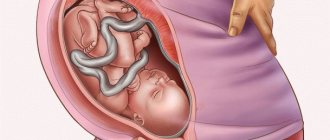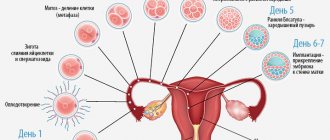This period is the end of the eighth month of pregnancy. The mother is happily awaiting the day of birth, she is actively preparing for the upcoming event, purchasing a dowry, collecting a maternity bag, selecting a maternity hospital, etc. Therefore, suddenly appearing discharge at 34 weeks of pregnancy can seriously frighten the mother. But unusual sensations and manifestations do not mean the presence of pathology.
The closer the expected due date, the more worried the expectant mother is
Yellow discharge during pregnancy
While expecting a child and preparing for motherhood, all women want to be absolutely healthy, but this does not always work out that way.
Therefore, you need to carefully monitor every change in your body and start treatment on time. In the early stages of pregnancy, women are hormonally in a state that resembles the second phase of the menstrual cycle. Fine
At this wonderful time, thanks to the active increase in the level of progesterone in the blood, the nature of vaginal discharge, the so-called leucorrhoea, changes. They become thicker and more viscous in consistency, and their number increases. At the same time, they retain their transparency or slightly whitish color, do not have an unpleasant odor and do not cause any unpleasant sensations in the fair sex. Remember, there should be no itching, burning, or irritation.
information Color change
leucorrhoea most often indicates the development of a pathological process. In most cases, a gynecologist can make a preliminary diagnosis based on the color of the discharge and suggest the cause of the pathology.
False contractions, Braxton Hicks contractions
By this time, a pregnant woman may begin to experience false contractions. Such contractions are often mistaken for real by young expectant mothers. They are usually accompanied by painful sensations and are irregular. The approximate duration of false contractions is 45 seconds. The pain during such contractions radiates to the lower back, back or groin. But true contractions move from the bottom of the uterus to the entire organ, from the lower back to the pelvis. False contractions most often appear in cases of multiple pregnancies. They appear unexpectedly and also disappear unexpectedly. They are harmless to the baby and mother.
Braxton Hicks contractions are completely painless, rhythmless contractions that often occur in the early stages of pregnancy. These contractions can be felt by placing your hand on your stomach. They are irregular and also do not indicate the onset of labor.
Discharge in late pregnancy
During pregnancy, a woman listens sensitively to changes in her body. She is concerned about the natural question - where is the norm and where is the pathology of these changes. This also applies to discharge, the nature of which may change during pregnancy. What discharge in late pregnancy should you be alarmed by? Should I worry if their number has increased?
From the moment of pregnancy, the nature of the discharge changes, which is explained by hormonal changes in the body. During this period, the production of the hormone progesterone, which is responsible for maintaining pregnancy, increases. In the early stages, the discharge becomes viscous and viscous, which is necessary for the formation of a mucus plug in the cervical canal, protecting the embryo from various infections. Already at the later stages of 36 or 39 weeks, the mucous plug comes off, which is evidence of an imminent birth. This plug resembles a clot of viscous, thick mucus streaked with blood.
Discharge in late pregnancy, which means the period from the 35th week until the onset of labor, often due to global hormonal changes in the body, increases
The body is actively preparing for an important period - the birth of a baby. Normal discharge is characterized by a mucous consistency, milky color and lack of odor.
Also, they should not cause unpleasant discomfort in the form of burning, itching, or other irritation.
- Transparent discharge in women
- Signs and causes of menstruation during pregnancy
- White curdled discharge in women
- Actovegin tablets during pregnancy
- Long delay in menstruation
- Redness of the cervix
- Basal temperature stays at 37
Often closer to the expected due date, around 37 weeks, a mucous brown discharge may appear. This is due to the fact that the preparatory stage of the cervix for childbirth begins. It softens and opens slightly, releasing the mucus plug. This phenomenon is quite normal and indicates an imminent birth.
However, in some cases, discharge in the last weeks of pregnancy should be alarming if foamy, green discharge is observed. bright red or non-slimy brown.
Bright red discharge is quite an alarming signal; it indicates placental abruption. In this case, you should call an ambulance immediately; you cannot do without medical intervention. The appearance of brown discharge without mucus should be a reason to visit a consultation, where, during a medical examination, their cause will be determined.
The appearance of greenish foamy discharge, accompanied by itching, most likely indicates infection. In this case, a visit to the doctor is mandatory for timely identification of the cause and completion of the necessary course of treatment even before the onset of childbirth.
Any suspicious discharge, accompanied by pain in the lower abdomen, changes in color and character, requires consultation with a doctor.
In the last weeks of pregnancy, you need to be careful and better play it safe, since we are talking about the health of the baby and his mother.
When you need to urgently seek help
Today we want to take a brief excursion so that you know exactly which discharge (at 35 weeks of pregnancy, as we see, almost a full “set” of them is inherent) is an alarming signal that cannot be ignored. The expectant mother should not rely on chance, and with every problem, contact a specialist who will assess the state of health. However, transparent and white discharge is most often a variant of the norm, even if it is accompanied by a sour odor, it still does not pose a threat to the life and health of the baby and mother. But a change in color almost always indicates a pathological process that needs immediate correction.
Brown discharge during pregnancy
Brown discharge is sure to cause concern in a pregnant woman. This concern is understandable because brown discharge is usually a sign of blood. But it is worth noting that such discharge is not always a pathology and an alarming symptom, because everything depends on whether there are other symptoms, as well as at what stage of pregnancy the woman is.
Causes of brown discharge:
1. Embryo implantation. Discharge with a consistency similar to cream, without itching and odor, which appears once, is due to this reason. This is due to the fact that during the implantation process, damage to blood vessels occurs, creating small discharge. They can usually be beige, pink or light brown in color. This reason is normal and does not pose a danger to the fetus.
2. Changes in hormonal levels. Scanty discharge, lasting a couple of days, without pain, may appear due to hormonal imbalances and occur approximately when menstruation should occur and does not pose any danger.
3. Threat of miscarriage. The cause of such discharge is usually the separation of the fertilized egg from the uterus. The vessels at the site of detachment are damaged and come out in the form of secretions interspersed with mucus. Discharge when there is a threat of miscarriage is accompanied by nagging pain in the lower abdomen, nausea and even vomiting. With such symptoms, it is necessary to call an ambulance, while remaining calm so as not to aggravate the situation. Timely seeking help can save a pregnancy.
4. Ectopic pregnancy. Such a pregnancy occurs when the fertilized egg attaches to the fallopian tube. The growth of the fetus ruptures the fallopian tube, creating internal bleeding. In this case, there is danger for the woman. Along with the discharge, a nagging pain may appear on the side where the embryo is located. You should seek help immediately after alarming symptoms appear.
5. Placental abruption. This happens for many reasons and is a very dangerous phenomenon for women and children. The danger is that the baby receives less oxygen and microelements, and the mother is at risk of severe bleeding. It can manifest itself either as small spotting brown discharge or heavy bleeding. Nagging pain and tension in the lower abdomen are additional symptoms that require going to an ambulance. Placental abruption has no treatment, and if the situation is not severe, they try to maintain the pregnancy. In difficult cases, a caesarean section is indicated.
6. Placenta previa. With this pathology, the placenta covers the os of the uterus. This creates very strong pressure on the placenta as the baby grows and damages blood vessels, causing bleeding.
7. Hydatidiform mole. This pathology has not been fully studied, but there is a theory that if an egg is fertilized by two sperm, then the chromosome set of the fetus turns out to be incorrect. With this pathology, the placenta and amniotic sac do not form; instead, a tumor appears on the walls of the uterus. Bloody discharge, sometimes with air bubbles, appears during hydatidiform mole. Other symptoms: vomiting, nausea, increased blood pressure and others. The pathology is removed surgically.
Almost all pathological causes of discharge are accompanied by additional symptoms and require urgent medical examination. But even when the discharge does not pose any danger, the treating gynecologist should be aware of its occurrence.
The material was prepared specifically for the site KID.RU
C-section
A caesarean section is a surgical procedure in which the fetus is removed from a woman's uterus and abdominal wall. There are many indications for such an operation: unfavorable development of pregnancy, the health of the woman, the condition of the fetus. A caesarean section can be emergency or planned.
Of course, the procedure itself and the postoperative period are individual in each medical institution. Most pregnant women wonder whether it is possible to resort to a caesarean section at the request of the patient.
The operation is possible only if there is a medical indication. Doctors can make such a decision if natural childbirth is impossible and the health of the pregnant woman is at risk.
A woman is usually admitted to the maternity hospital 1-2 weeks before surgery. Before the operation, a full medical examination is carried out in the hospital. Among the methods of pain relief, spinal anesthesia is the safest. In this case, only the lower part of the body is subject to pain relief. The woman in labor is conscious. General anesthesia is used only in 5% of cases.
How is the procedure itself carried out? To begin with, the mother's belly is wiped with an antiseptic and covered with a sterile sheet. A woman cannot see her stomach due to a barrier installed in the chest area. Doctors make a transverse incision in the abdominal cavity above the pubis, then open the amniotic sac. The doctor removes the baby and cuts the umbilical cord. Then the doctor removes the placenta by hand and sews up the incision on the uterus and abdominal cavity with special threads, which will later dissolve. The skin is closed with staples or stitches and a sterile dressing. The operation lasts on average from 20 to 40 minutes.
After a caesarean section, a woman cannot give birth for the next 2 years. During this time, the woman’s body will be able to fully recover. If in the case of a second pregnancy there are no contraindications to natural childbirth, there is no need to resort to a caesarean section.
Harbingers of childbirth
Our body is designed extremely wisely. Gradually, step by step, your body will prepare itself for childbirth. You just need to pay attention in time to some physical and psychological changes happening to you.
Appear from the 30th week of pregnancy. These are painless contractions of the uterus - at first rare and irregular. The stomach seems to “turn to stone” for 5-10 seconds. Most often this happens in a horizontal position. Such contractions do not require any special treatment, thus the uterus is simply preparing for the more serious work that lies ahead. Unpleasant sensations during such training contractions can be reduced by taking a warm bath (36-37 C) with sea salt. If a bath is not available, you can try to breathe with your stomach - to control, place your hand on your stomach, it should rise during inhalation.
Pelvic bones and lower abdomen
Bones and ligaments also prepare for childbirth. From 32-34 weeks you notice how the area of the sacrum, pubis, and hips is pulled, and your gait becomes slack. Don't forget about stretching exercises (for example, the butterfly pose is suitable). Sitting on the floor, spread your legs, then bend them at the knees and place them so that your feet are touching and your knees are pointing in opposite directions.
Place your palms on your knees and, using gentle pressure, try to press your knees to the floor, pulling your heels towards your perineum. Take your time
Feel the moment of extreme tension, after which the muscles will become a little softer and more pliable and allow you to bring your knees a couple of millimeters closer to the floor.
Another well-known exercise is the “cat”. Standing on all fours, alternately round your back and bend it as low as possible. With the help of such simple exercises, as well as massage and a swimming pool, you will help your bones and ligaments prepare for childbirth.
From this same period, you may notice nagging pain in the lower abdomen, similar to menstrual pain. A warm bath, stroking the abdomen, and knee-elbow position for 5-10 minutes will again come to the rescue.
Usually, at 36-38 weeks, the expectant mother notices that it has become much easier for her to breathe. This baby adjusts its head to the entrance to the small pelvis and actually sinks lower. The pressure on the mother’s diaphragm and stomach decreases, and painful heartburn disappears. But as pressure shifts to your pelvic organs, prepare to put more strain on your bladder. Therefore, you may feel the urge to urinate more often than before.
During this period, hormonal levels change. As a result, mucous discharge from the vagina and nasal cavities increases. A couple of weeks before giving birth, weight often decreases by 0.5-1 kg.
Certain changes also occur in the psychological mood. For no apparent reason, you suddenly want to clean your apartment until it shines, rearrange the furniture, or at least continuously ventilate the room - after all, you are preparing your “nest” for a little chick. Considering that before this you felt tired and apathetic, the changes are quite noticeable. It is useless to fight the nesting instinct, you just need to survive it
But be careful not to overdo it in preparation for your most important meeting.
Feelings of a pregnant woman
Expecting twins - double joy in the family
Now mommy’s body has changed dramatically, she has gained weight, and her belly has become noticeably rounder. Therefore, the girl’s feelings became completely different. This is only a temporary discomfort, so you just need to get along with it. Sensations of movement in the liver and ribs may be especially sensitive. Mothers often complain of pain in this area. In this case, moving to a different position of the body, light rest or a walk can help. By the way, resting on the left side is much more comfortable than on the right.
Painful sensations in the lumbar area become habitual; they are observed in 2/3 of all pregnant women. The fruit has grown noticeably, so the center of gravity is shifting. The female body is in complete chaos, it is shaken by hormonal changes, and the joint and ligamentous tissues begin to relax, which is reflected in the walking style and provokes pain symptoms. To alleviate the condition, a woman is recommended to wear a bandage and choose the most comfortable shoes.
The patient is advised to remove the load from her legs more often by raising them higher. Limb pain is now becoming common as fetal weight continues to increase. Place your feet on a footrest when sitting, and before going to bed, it is helpful to massage them and take a foot bath with cool water. It is necessary to carefully monitor your condition and internal sensations. If bloody discharge and painful cramping sensations appear, then you need to urgently call an ambulance and go to the maternity hospital.
Stomach
The girl’s belly has grown noticeably and no longer fits into her usual clothes. Due to the large size of her belly, mommy begins to move extremely carefully. She gets out of bed especially carefully. To prevent stretch marks from forming on the abdomen, it is recommended to lubricate the skin with special anti-stretch mark cosmetics.
During the first pregnancy at this stage, discomfort may occur due to pressure from the fetal head. Sometimes, already at 34 weeks, the baby gradually begins to descend into the pelvic cavity. The baby's head moves closer to the birth canal and begins to put pressure on the pelvic organs. But this is often recorded much later, a couple of weeks before delivery.
Narrow issues of pregnancy
During pregnancy, your physical indicators undergo changes and many things that were allowed before pregnancy are now taboo.
Alcohol at 33 weeks
During pregnancy, you must strictly give up alcohol and smoking. You can’t even imagine what changes occur in the fetus’s body after one glass of wine.
- Alcohol easily penetrates the baby’s circulatory system and the still fragile kidneys and liver need to make enormous efforts to remove toxins from the body;
- In addition, ethanol directly affects the brain, the convolutions of which just develop at 33 weeks of pregnancy. No one can predict what consequences to expect from such a treat.
Temperature
You should know that during pregnancy, your body temperature can be as high as 37 degrees, with increased sweating and breast swelling.
If you feel normal, then there is no reason to worry, it’s just that your body works for two and such an increase in temperature is normal.
Another thing is the appearance of traditional cold symptoms, such as cough or runny nose; most likely, a temperature of 37 will indicate the onset of an illness, the treatment of which must be started immediately.
Cold at 37 weeks of pregnancy
If you have a temperature above 37 at the 33rd week of pregnancy, along with a runny nose, cough, sore throat or aching joints, you must adhere to bed rest and begin to treat the disease.
But not all proven means are currently allowed for you.
- You should absolutely not take aspirin, analgin, or a number of antibiotics;
- You should also be careful with traditional methods. So, during pregnancy, there can be no talk of any mustard plasters;
- The optimal treatment for a cold at 33 weeks of pregnancy is to drink plenty of fluids, eat foods rich in vitamin C, gargle with infusions of chamomile, eucalyptus, sage, saline solution for rinsing the nose, a one-time dose of paracetamol or ibuprofen at temperatures above 38 degrees;
- Read more about treatment in the article Colds during pregnancy>>>
Sex
If there is a mutual desire of the partners, and doctors have not identified any contraindications related to the threat of miscarriage, you can safely have sex at 33 weeks of pregnancy.
Do not forget that the process itself should be relaxed, without deep penetrations, and the position you choose should not harm the baby. The ideal option is penetration from behind.
Green discharge
If a woman has green or yellow discharge that bubbles, this is a sure sign of a disease transmitted through sexual intercourse. You should immediately consult a doctor who will prescribe appropriate treatment.
Green discharge may also appear in the vagina if there are harmful bacteria present. Copious greenish mucus indicates an acute vaginal infection. If such discharge has a fishy odor and peels off in films, this is vaginal dysbiosis.
The vaginal microflora is disrupted by taking antibiotics. Sometimes green mucus can be a sign of simple inflammation of the uterus and appendages.
Such discharge, accompanied by pain in the lower back or lower abdomen, general weakness and dizziness, requires urgent medical diagnosis and consultation with a doctor.
Causes of brown discharge at 34 weeks of pregnancy
So, if you are 34 weeks pregnant, brown mucous discharge is abnormal. But for what reasons can they start? It is worth listing them below.
Placental abruption. The placenta is where the fetus is located and feeds through the body. Without her, the baby simply cannot exist. And if for some reason placental abruption occurs (abdominal trauma, uterine malformations, etc.), then bleeding will occur. Of course, this phenomenon is usually accompanied by sharp pain and bleeding, but if the placenta detaches gradually, the blood on the way to the vagina will turn brown, and the pain may not be intense. · Threat of premature birth. But in this case, other symptoms are usually observed: nagging or cramping pain in the lower abdomen or lower back, as well as hardening of the abdomen.
Cervical erosion. This is a condition in which the lining of the cervix becomes inflamed, so that it may bleed, which will be accompanied by nagging pain in the lower abdomen, as well as brown discharge.
Placenta previa. If the placenta is located close to the cervix, then the growing fetus and uterus can disrupt the integrity of its vessels, which can cause slight bleeding and brown vaginal discharge at 34 weeks.
Injury to the mucous membrane of the vagina or cervix, for example, after sexual intercourse or vaginal ultrasound. · Infections of the genital tract can also cause symptoms such as discharge.
Hydatidiform mole is a pathology in which the placental villi turn into blisters, which provokes bleeding or discharge.
Human papillomavirus and other viral diseases.
Uterine rupture. This condition can occur if there are malformations of its development or if there are scars on it (after a cesarean section or abortion).
What to do?
So, what to do if brown discharge starts at 34 weeks of pregnancy? This symptom is in most cases a consequence of some abnormalities during pregnancy or in the body of the expectant mother. So if such discharge occurs, you should not wait for a scheduled visit to the gynecologist.
It is best to call an ambulance so that all examinations are carried out as soon as possible. Most often, emergency doctors advise immediate hospitalization, which allows you to quickly take the necessary measures and avoid tragic consequences.
The presence of discharge during pregnancy is explained by the action of hormones. So hormonal changes (lack of hormones or increased amounts) may cause changes in the amount and consistency of discharge. This is such an unusual addiction.
In conclusion, it remains to add that any alarming symptoms during pregnancy should alert the expectant mother, as they can be a signal of very serious problems. So if brown discharge occurs, it is better to consult a doctor.
At 33 weeks of pregnancy, mucous discharge
Using found pages - 216931
I wanted to ask, I’m 41 weeks pregnant, yesterday I had bloody mucus discharge all day, this morning there was bloody discharge
transcript of fetal CTG 33 WEEK? help determine the date of conception? Pain in the lower abdomen, 39 weeks pregnant?
And if before the 12th week of pregnancy a woman usually observes mostly viscous and mucous discharge from the vagina, then, starting already weeks from the 13th current pregnancy, as the normal production of hormones such as estrogens is activated, there will be mucus.
Mucus discharge during pregnancy can occur up to the 12th week of pregnancy (during the first trimester).
Thick, viscous, viscous mucus fills the cervical canal and prevents infection from entering the uterine cavity.
Throughout pregnancy, it protects the entrance to the uterus, and only on the eve of childbirth, the woman’s body begins to get rid of it with gradual viscous mucous secretions.
Mucus discharge is typical during the first 12 weeks of pregnancy (first trimester).
Thick, viscous and viscous mucus fills the cervical canal and prevents infection from entering the uterine cavity.
37 weeks of pregnancy. Entirely in the form of one rather large lump of mucus interspersed with blood; Sometimes in the form of pink mucous discharge or with a small amount of blood.
The cause of mucous discharge during the first 12 weeks of pregnancy is the activity of the hormone progesterone, which regulates the functioning of the woman’s reproductive system during this period.
Mucous discharge during pregnancy in the second trimester may turn out to be... amniotic fluid.
Therefore, in the case of a short pregnancy (14-18 weeks), the woman is offered to terminate the pregnancy.
I am 37-38 weeks pregnant, my due date is March 27. Today I noticed mucous discharge with blood. Is this how it should be?? .
I am bothered by periodic thick mucous discharge, sometimes up to a teaspoon comes out a day. In my last pregnancy, my gynecologist said that such discharge from the 33rd week was a traffic jam.
Obstetric timing and fetal age
In fact, the 34th week of gestation, according to obstetric calculations, is the ninth month of pregnancy. The fetus is at 32 weeks of development, but judging by the calendar, the pregnant woman is now 7 months and 24 days pregnant. There is nothing left until the birth.
- The baby has grown significantly, and his belly has become almost the maximum size.
- The fetus occupies almost all the available space in it; it has already prepared for its main event - birth, so it is positioned with its head towards the entrance to the uterine cervix.
- Although some women may have options for a different location, for example, across the uterus or butt down.
- It’s too early to judge now, but if the baby does not change position in the coming weeks, the patient will be scheduled for a cesarean section.
- The baby gains a few grams every day; he completes the formation of all vital functions and structures.
- If delivery suddenly begins at exactly this time, then he will be able to survive, but he will need the help of doctors and their supervision in the first weeks.
Now the baby is actively accumulating iron and calcium in order to provide himself with everything necessary during his existence outside the mother’s womb in the first months of life. Therefore, it is important for a woman to eat properly and get proper rest during this period.
The reasons for their appearance depending on the period
Yellow discharge in 1st trimester
At this time, the coloring of leucorrhoea yellow most often occurs due to the following reasons:
Colpitis is an inflammation of the vaginal mucosa.
Yellow discharge in the first trimester of pregnancy is often its first and only symptom.
additionally The cause is an infection, to identify which it is necessary to undergo a general smear for flora, culture with determination of antibiotic sensitivity and be examined for sexually transmitted infections. Based on the test results, the doctor will prescribe the necessary treatment for you.
In the early stages, most drugs are not used due to the harmful effects on the fetus, so there is a list of diseases that begin to be treated only after 10 weeks, and more often later - after 12.
Cervicitis is an inflammatory lesion of the cervix.
The examination is the same as for colpitis, plus an analysis for herpes viruses and human papillomaviruses. It is advisable to undergo colposcopy - examination of the cervix with a special device that allows you to enlarge the image several times.
Thrush, or candidiasis.
Abundant white and often even yellowish discharge during pregnancy is one of the manifestations of this disease, which is unloved by all women.
Physiological immunosuppression during the period of preparation for motherhood plays a major role in its occurrence. It can be aggravated by taking antibiotics, an allergic reaction to synthetic underwear, scented pads and intimate hygiene products.
- Bacterial vaginosis
can also be one of the causes of yellow-white discharge during pregnancy. It is a disruption of the normal microflora in the vagina, accompanied by an unpleasant “fishy” odor from the genital tract, and leucorrhoea often becomes “bubbly.” It is not transmitted sexually. - Infected abortion
.
Yellow discharge in the first trimester of pregnancy along with fever, chills, and inflammatory changes in the blood often indicates the penetration of infection into the uterine cavity, and sometimes blood poisoning. This happens with criminal abortions performed outside medical institutions, without observing sanitary rules. Fortunately, this is now very rare.
Yellow discharge in the second trimester
During pregnancy, yellow discharge during this period occurs for the same reasons as in the first trimester, but the prognosis for the expectant mother and child during this period is more favorable due to expanded treatment options.
Yellow discharge in the third trimester
By this time, all systems and organs of the fetus have already formed, and its active growth begins.
- Yellow discharge during pregnancy in the third trimester, along with the above reasons for the early stages, can occur due to infection of the membranes of the fetus and infection of the amniotic fluid. This pathology is called chorioamnionitis.
It poses a great danger in the later stages due to the risk of intrauterine infection of the baby. It can occur during childbirth, during a long anhydrous period. In addition to pathological discharge, it is accompanied by fever and poor blood tests (a large number of leukocytes in the blood and smears). - On the eve of childbirth, usually at 37 weeks and a little later, the mother’s body begins to actively prepare for the birth of the baby. At the same time, the cervix shortens, begins to soften, and its canal gradually opens, and the mucous plug
. Its quantity is about 20-30 ml. Color varies from white to yellow, often streaked with blood. This is an absolutely normal phenomenon that does not require seeing a doctor.
important From all of the above, you can draw a logical conclusion for yourself, expectant mothers, that the coloring of leucorrhoea yellow in 99% is pathological in nature. Even if you have a short period of time, say 9 weeks, and you haven’t registered yet, you shouldn’t delay contacting a gynecologist
It is easier to defeat any disease at an early stage
Even if you have a short period of time, say 9 weeks, and you have not yet registered, you should not delay contacting a gynecologist. It is easier to defeat any disease at an early stage.
What is your baby like?
Although childbirth can take place at this time, it cannot be called favorable, because the baby still has some time to develop and gain the necessary weight inside the mother’s womb. Although now the weight of the fetus exceeds 2 kg and 45 cm. The child develops individual facial features that are characteristic only of him. The original hairs (lanugo) gradually disappear, the baby’s skin becomes light pale, and the cheeks acquire rounded outlines.
- The baby begins to actively train sucking activity, using his finger for this, while swallowing amyloid liquid occurs, which also trains the gastrointestinal structures.
- As a result, renal activity is improved, because about half a liter of urine returns to the amniotic fluid.
- In general, the child will be able to breathe independently upon the onset of labor, but heat retention is not yet developed, so such newborns are placed in an incubator.
- The baby's ears have already separated from the head, and the original lubricant has disappeared from the body.
- The baby is actively stocking up on the necessary microelements, although it is still completely dependent on the mother, because it continues to receive nutrition through the umbilical cord.
- The baby kicks hard because he feels cramped. It is by the movements that the mother will be able to determine the mood of the belly-dweller - he is happy or alarmed.
- Sometimes mommy notices rhythmic twitching of the abdomen, which is associated with the baby’s hiccups. This is not scary, this is how the child trains the respiratory and digestive structures.
- At this stage, experts recommend reading fairy tales to the baby, singing nursery rhymes to him, and talking to him.
If suddenly the movements stop or become too active, then you need to consult a specialist, because such symptoms are accompanied by intrauterine suffering of the fetus. Over a period of 12 hours, the baby should move at least 10 times, and ideally about 2 times within an hour. At the same time, during the daytime the baby does not move as much, because the mother is busy with daily affairs, but at rest the baby’s motor activity becomes pronounced. During this period, the pregnant woman is actively developing fetal nervous system structures, and the adjustment between all working systems and organs is actively taking place.
33rd week of pregnancy Pregnancy calendar
The 33rd week of pregnancy is an important period for the development of the baby. He has almost acquired the natural appearance of a baby. Fat deposits accumulate in his tiny body, wrinkles on his face gradually smooth out, and his skin color turns from red to a healthy pink.
Fetus at 33 weeks of gestation
At the moment, all the baby's toes and hands are covered with grooves - this is a skin pattern. There is still a lot of room for maneuver, and so the child continues to tumble and push. But the space is increasingly narrowing, and after the end of the week the somersaults will stop. Your child sleeps a lot. Having woken up, the baby begins to listen to his feelings and sounds. Maybe he even sees some shadows. His activities to understand the environment continue. In his brain, billions of neurons are now making trillions of trillions of new connections. The baby often gives you no rest, because he is already quite big and it becomes cramped for him in his mother’s house. Therefore, you should be understanding of his regular kicks and pushes. Sometimes the mother clearly feels the baby hiccupping. This is not a pathology, no need to worry. In some cases, especially in first-time mothers, abdominal prolapse is observed at the 33rd week of pregnancy. The color of your baby's skin gradually changes, and now it is no longer so red, but rather pink. The hairs covering the baby's body disappear.
Now the baby’s length from the crown to the sacrum is almost 30 cm, and he weighs about 2000 g.
Woman 33 weeks pregnant
A lot of time has already passed from conception to this week, namely seven and a half months or 31 weeks. The uterus has increased significantly. As the number of red blood cells begins to match the volume of plasma, physiological anemia gradually loses its severity. The need to urinate becomes more frequent. At night you may have amazingly vivid dreams. You probably couldn’t even imagine that your belly would grow to such a size! Until the thirty-third week of pregnancy, the stripe on the abdomen became even darker, and the navel became flat or even turned in the opposite direction and now sticks out. Don't worry, everything will return to its place after childbirth.
Continue learning about the birth process, your newborn baby, and the postpartum period. The more you understand now, the easier it will become later.
Congratulations, you are 33 weeks pregnant!
Recommendations at 33 weeks of pregnancy
Regularly perform a set of exercises to prepare your body for childbirth. Read specialized literature - the more you know about this process, the better.
By being prepared, you will be able to control the process and behave correctly during childbirth. This trimester you need to do CTG at least twice, sometimes more according to the doctor's indications.
Cardiotocography is also prescribed by a doctor at 33 weeks of pregnancy. This procedure helps to identify the motor activity of the fetus, its heart rate, as well as the tone of the mother’s uterus.
Baby development
What happens to the fetus at 34 weeks of pregnancy? So, your baby is already completely ready for independent life, although the thirty-fourth week period is still too early for childbirth. How much does your baby weigh now?
The normal weight of a child at 34 weeks of pregnancy varies widely. On average, the weight of the fetus at 34 weeks is just over 2 kg. However, do not be upset if your baby weighs a little less or, on the contrary, has gained more than normal.
The fact is that the weight of a child at 34 weeks depends on many factors, the main one of which is heredity. It is clear that tall and dense parents will have a larger child than miniature ones.
If the fetus at 34 weeks of gestation weighs 2.5 or even 3 kg, this does not mean that it will be born very large. It is quite possible that in the remaining weeks he will gain only 200-300 grams.
Fetal development at 34 weeks of gestation is characterized by the following changes:
- the accumulation of fatty tissue is proceeding at an active pace, now the fat content is about 8% in relation to the total body weight;
- The amount of fat affects how the baby looks. Now his skin is no longer wrinkled and red, but rather smooth and light pink;
- the original fluff gradually disappears, and the hairs on the head become increasingly dense;
- the digestive system produces enzymes that will be needed to absorb mother’s milk;
- A baby at 34 weeks of pregnancy has all the senses, he hears sounds, feels touch, tastes and smells. His vision is still imperfect, it will continue to develop after birth.
Parents are advised to talk with their baby more often. You can sing him songs and play pleasant melodic music.











